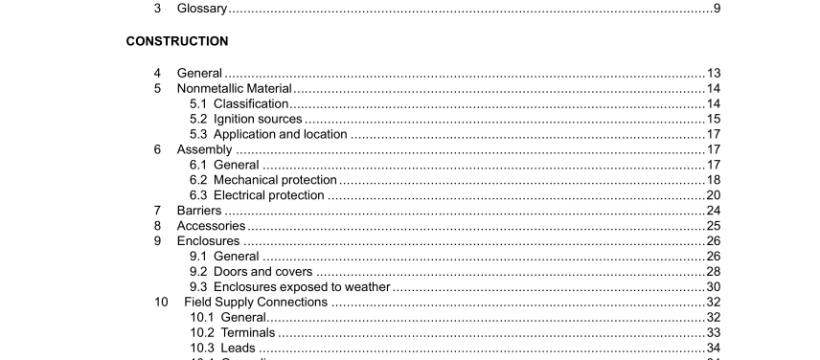UL 1963-2021 pdf download.Refrigerant Recovery/Recycling Equipment.
3.2.2 ADJUSTABLE SPEED DRIVE SYSTEM – An interconnected combination of equipment that provides a means of adjusting the speed of a mechanical load coupled to a motor. A drive system typically consists of an adjustable speed drive and auxiliary electrical apparatus. 3.3 BARRIER, i INSULATING – A partition for the isolation of high-voltage electrical components or i circuits. 3.4 BARRIER, MECHANICAL – A rigid partition for the isolation of ignition sources, moving parts i or protection of wiring. 3.5 CABINET – The part of the product that provides physical protection to insulated wiring, enclosures, moving parts, motors, enclosed electrical parts, refrigeration tubing or other parts that may cause a risk of injury to persons. 3.5.1 CAPACITOR, CLASS Y – Capacitor or resistor-capacitor unit of a type suitable for use in situations where failure of the capacitor could lead to danger of electric shock. (Examples would include capacitors connected across the primary and secondary circuits where electrical isolation is required to prevent an electric shock or between hazardous live parts and accessible parts.) 3.6 CAPILLARY TUBE – Device made of tubing with an outer diameter of less than 3/16 in. (4.7 mm) and used to reduce the pressure of the refrigerant between the condenser and evaporator. It also regulates the refrigerant flow. 3.7 CIRCUITS, ELECTRICAL – a) Extra-Low-Voltage – A circuit supplied by: 1) An AC potential of not more than 42.2 volts peak (30 V rms) and power of 100 VA or less; or 2) A DC potential of 30 V supplied by a primary battery; or 3) A Class 2 transformer, as defined by the National Electrical Code, NFPA 70; or 4) A combination of an isolating transformer and fixed impedance which as a unit complies with all performance requirements for a Class 2 transformer. b) High-Voltage – A circuit involving a potential of not more than 600 volts and having circuit characteristics in excess of those of an extra low-voltage circuit.
3.8 COMPONENT – A device or fabricated part of the recovery/recycling equipment covered by the scope of a safety standard dedicated to that purpose. If incorporated in recovery/recycling equipment, a product that is otherwise typically field installed (e.g. luminaire) is considered to be a component. Unless otherwise specified, materials that compose a device or fabricated part, such as aluminum or copper, are not considered components. Generally, components are incomplete in construction features or restricted in performance capabilities. Such components are intended for use only under specific, limited conditions, such as certain temperatures not exceeding specified limits. 3.9 COMPRESSOR – A refrigerant motor-compressor with the suction side (low side) intended to be connected to a system from which the refrigerant is being removed. The discharge side is connected to the refrigerant recovery tank. 3.10 CONTROL CIRCUIT – A circuit that carries electric signals directing the performance of a controller that in turn, governs power delivered to a motor or other load in the equipment. A control circuit does not carry main power current.
3.11 CONTROL CIRCUIT, DIRECT-CONNECTED HIGH-VOLTAGE – A circuit that is supplied from a branch circuit separate from a branch circuit that supplies other loads within the equipment. It is not tapped from the load side of the overcurrent device(s) of the controlled circuit(s) within the equipment. 3.12 CONTROL CIRCUIT, TAPPED HIGH-VOLTAGE – A circuit that is tapped within the equipment from the load side of the overcurrent device for the controlled load. 3.12.1 CONTROL FUNCTION (CLASS A, B or C) – Actuation of an electrical or electronic device (or devices) that are part of the refrigerant recovery/recycling equipment. Software may be used in the actuation of the device(s). Class A is not intended to be relied upon to reduce the risk of electric shock, fire or injury to persons. Class B is intended to reduce the risk of electric shock, fire or injury to persons. Class C is intended to further reduce the risks involving special hazards, such as explosion. A device with Class A actuation is considered to be an operating control, whereas a device with Class B or Class C actuation is considered to be a protective control.UL 1963-2021 pdf download.
UL 1963-2021 pdf download
